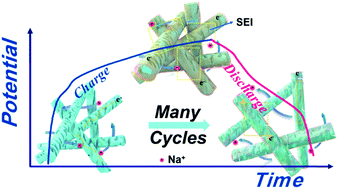Phosphorus-doped porous hollow carbon nanorods for high-performance sodium-based dual-ion batteries†
Abstract
Sodium-based dual-ion batteries (NDIBs) have attracted extensive attention in recent years owing to both relatively high power density and high energy density. However, the lack of sufficient anode materials for sodium-ion insertion/extraction has greatly hindered the development of NDIBs. Herein, phosphorus-doped hollow amorphous carbon nanorods (P-HCNs) were synthesized by an in situ method as anodes for NDIBs. Phosphorus doping results in microstructure bulges in P-HCNs and enlarges the interlayer spacing, which facilitate a fast passage of sodium ions. In addition, this amorphous carbon only exhibits a sloping potential profile and lacks a low voltage platform. The most reversible capacity for sodium storage is from high sodium intercalation potential, thus effectively alleviating the dendrite formation. As a result, it enables the soft carbon to have a long cycling life and excellent rate capability. Phosphorus doping and amorphous carbon synergistically improve the chemical adsorption ability. The reversible specific capacity of P-HCNs can be up to 121 mA h g−1 after 1500 cycles at the current density of 500 mA g−1 with 90% capacity retention maintained. It also has a high energy density of 76 W h kg−1 at a power density of 891 W kg−1. The rapid ion transportation, high conductivity, and outstanding physical and chemical adsorption together contribute to premier cycling stability, rate performance, and coulombic efficiency. This current research work is significant for NDIBs.



 Please wait while we load your content...
Please wait while we load your content...